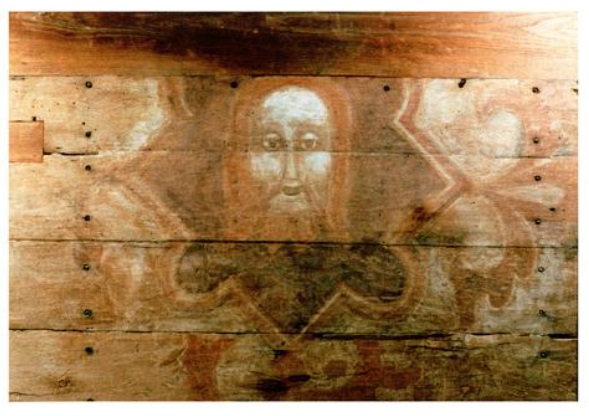
One evidence the Templars is associated with the TS is the Templecombe panel.
It has been reported by Ian Wilson (The Turin Shroud„ Gollancz 1978), and by others like
myself who have based their information on Wilson’s account, that a painting of the head of
Christ was discovered by accident in an outbuilding in Templecombe in the 1950s. This
remarkable artefact has been on display in the Templecombe parish but attracted little special
attention until Wilson, in 1978, published his important theory that the painting was a direct
copy from the face of the image of the man on the Holy Shroud, one of many such copies
made by the Templars to be kept in their various preceptories to remind them of their most
precious possession, the Holy Shroud, and to be used as an object of veneration.It measures some 4’9″ wide by 2’9″ high and is believed to be about 2″ thick.
Alan Whanger of Duke University has pointed out that
under his method of polarising overlay technique which he applies to any supposed copy of
the Shroud, the Templecombe panel has 125 points of congruence with the Shroud face.The painting is on a panel with hinge and lock facilities and yet it is painted with the panel
horizontal which would not have been done on, or for, an upright door.The panel is clearly then, the lid of a great box. The dimensions are almost exactly those one
would choose to contain the Holy Shroud as we know it when folded in eight as it usually
was during the middle ages. The fleur-de-lys decoration of the panel strongly suggests French
influence and the quatrefoil design is recurrent in Templar (and other) decorative motifs.
Templecombe is six miles from the probable site of the centre of Arthurian activity and the
quest for the Holy Grail, now shown by strong evidence actually to have been the Holy
Shroud, and is therefore a most likely place for this most precious of Christian relics to have
been taken by its owners, the Knights Templar, until Europe was considered safe for its
return.
https://www.shroud.com/pdfs/n17part2.pdf

https://en.wikipedia.org/wiki/File:St_M … _Combe.jpg
The church in Templecombe was built in the 12th century and once held by the Templars.
The Anglican Church of St Mary at Templecombe, within the English county of Somerset, was built in the 12th century and is a Grade II* listed building.One of the manors within the parish was held by Earl Leofwine who gave it to Bishop Odo of Bayeux after the Norman Conquest. The church was probably established during the period when the manor was held by Shaftesbury Abbey, but granted to the Knights Templar while it was held by his descendant Serlo FitzOdo,[3][4] who established a preceptory in the village in 1185.[5][6] The preceptory served as an administrative centre for the lands held by the Templars in the south west of England and Cornwall. It may also have been used to train men and horses for the Crusades.[7] After the Knights Templar were suppressed following the 1307 order by Pope Clement IV,[8] it was granted to the Knights of St John, who held it until the dissolution of the monasteries.
https://en.wikipedia.org/wiki/Church_of … emplecombe
The painting is dated to the 13th century.
In the church is a painting on wooden boards of a head, which was discovered in the roof of an outhouse of a local building in 1945.[12] The tenant of the cottage was collecting wood in an outhouse where part of the ceiling had fallen down. She noticed a face above her which was on a wooden panel fixed by wire to the inside of the roof and previously plastered over.[13]The painting is thought to be from the 13th century,[1] and connected with the Templecombe Preceptory (or Combe Templariorum) which was established in the village in 1185. It was given to the church in 1956.[14]
Restoration work in the 1950s and again in the 1980s has identified gold stars on the picture and microscopic evidence for bright colours which are no longer in evidence.[15] The colours were present in the 1940s when it was discovered, but impaired when the local vicar cleaned it in his bath with Vim.[7] The addition of a keyhole and hinges at some time in the past suggests it was used as a door.[14]
For many years the head has been believed to be that of Christ but without the halo which was the norm in religious iconography at the time. The Knights Templar were suppressed partly because of their use of the image of Christ without the halo.[3] There has been speculation linking the image with the Shroud of Turin.[16] Other explanations suggest the image is not of Christ but of John the Baptist.
https://debatingchristianity.com/forum/viewtopic.php?p=1122402#p1122402
